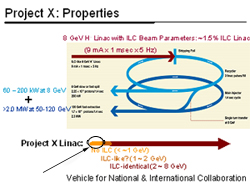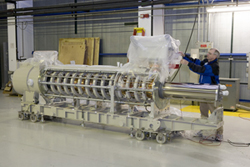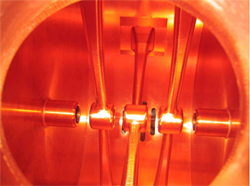Toward the intensity frontier
Today's column is written by Robert Webber, APC/HINS Department Head
 |
| R&D done by the HINS program could fit into the first 50 meters of the Project X linear accelerator.
|
 |
| APC/HINS Department head Bob Webber stands in front of the 325 Mhz klystron used in the HINS program.
|
 |
| View of "spokes" inside a HINS normal conducting RF cavity.
|
Fermilab's Steering Group has developed a plan to keep the laboratory at the frontier of scientific discovery should construction of the International Linear Collider be delayed. The plan calls for building Project X, a powerful proton beam facility for experiments at the intensity frontier. An R&D program currently underway, the High Intensity Neutrino Source program, could give Project X a big boost, especially in the first 50 meters of the linear accelerator, where the acceleration process begins (circled in image).
The two-year old HINS collaboration, comprising Fermilab's TD, PPD, AD and APC, together with Argonne, Berkeley and Brookhaven Laboratories, has conducted a R&D effort to develop never-done-before accelerator designs and technologies for intense proton beams. The HINS linac design has required the development of ground-breaking approaches, including use of superconducting, spoke-type accelerating cavities for low-energy acceleration and superconducting solenoid magnets for tighter beam focusing, technologies never previously used in a high-intensity machine. Construction and commissioning of these accelerator components that might serve as the front end of the Project X linac are proceeding well in the Meson Building.
The superconducting "spoke" RF cavities operate at 325 MHz, one-quarter the ILC's cavity frequency. This harmonic frequency relationship is necessary for compatibility with the ILC cavities that would make up most of the Project X linac. The "spokes" in these cavities form properly-spaced radio frequency accelerating gaps along the beam path inside a larger cavity volume.
Recently, the collaboration successfully demonstrated an innovative high-power RF "valve" designed by APC physicist Dave Wildman that allows individual control of multiple RF cavities fed by a single power source, the 325 Mhz Toshiba klystron. The single large klystron allows operators to turn on and off power for all of the RF components from a single point, making it more cost effective than conventional designs using dozens of smaller klystrons.
The challenge of keeping U.S. particle physics on the pathway to discovery will require many technological breakthroughs in the years ahead. Within the HINS accelerator R&D program, the process is well underway.
|